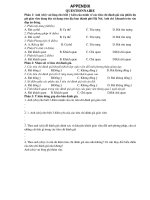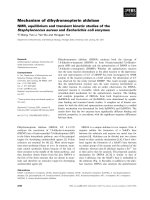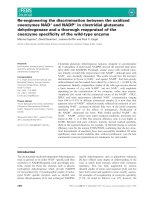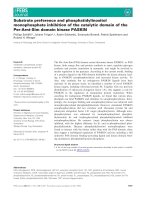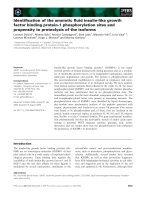examining and integrating transaction cost economics and resource-based view explanations of the firm’s boundary choices
Bạn đang xem bản rút gọn của tài liệu. Xem và tải ngay bản đầy đủ của tài liệu tại đây (697.48 KB, 147 trang )
Examining and Integrating Transaction Cost Economics and Resource-Based View
Explanations of the Firm’s Boundary Choices
DISSERTATION
Presented in Partial Fulfillment of the Requirements for the Degree Doctor of
Philosophy in the Graduate School of The Ohio State University
By
Nilesh Khare
B.E. CFA (India) P.G.D.B.A.
Graduate Program in Business Administration
The Ohio State University
2010
Dissertation Committee:
Professor Jay B. Barney (Advisor)
Professor Michael J. Leiblein (Co-Advisor)
Professor Claudio Gonzalez Vega
Professor Mona Makhija
Copyright by
Nilesh Khare
2010
ii
Abstract
The three essays of this dissertation complement extant research by explicitly
revealing the boundary conditions of the central predictions of transaction cost economics
and by offering traceable novel insights from the integration of this approach and
resource-based explanations of the firm’s boundary choices.
Chapter two employs a semi-formal modeling approach to examine the central
predictions of transaction cost economics regarding asset specificity and governance
forms. The analysis assumes away capability differences across firms. The approach
factors several issues that are often acknowledged but rarely examined in the extant
research, such as diminishing returns to transaction specific investment, endogeneity in
asset specificity and governance form choices, lack of focus on both the parties in a
transaction, and ex-ante alternative uses of resources. Incorporating these factors into the
analysis provides a more precise articulation of the boundary conditions surrounding the
central prediction of transaction cost economics.
Chapter three extends the semi-formal model presented in the chapter two by
considering differences in productive capabilities across potential exchange partners to
integrate transaction cost and resource-based perspectives on the firm’s boundary
choices. In particular, the analysis focuses on whether and how differences in the levels
of asset specificities across transaction stages and differences in the productive
iii
capabilities across potential partners affect governance mode choices. The analysis
identifies the specific conditions where the application of the resource-based logic may
alter standard transaction cost economics predictions.
Chapter four further extends the model by considering firm specific governance
capabilities. It examines the relationship between governance capabilities and governance
forms by integrating asset specificity, productive capability, and governance capability
perspectives on the firm’s boundary choices. The analysis examines whether and how
differences in productive capabilities across potential partners and the partner firm’s
governance capabilities may affect the relationship between the focal firm’s governance
capabilities and governance forms. This chapter suggests that only in specific conditions
a firm’s governance capabilities related to a specific governance form favor that
governance form.
The dissertation offers several opportunities for future research and presents an
approach that can be exploited to examine these opportunities.
iv
Dedicated to the dynamics of innate and unrelenting human spirit of inquiry,
reasoning and learning, and the limits of human intellect— Neelansh and Priyansh, my
sons, who, for me, symbolize this dynamics the best.
v
Acknowledgments
I am very grateful to my advisors, Jay Barney and Michael Leiblein, for their
continued efforts to mentor me for my career and assist in my work. This dissertation
would not have been possible without Jay’s flexibility, ability to see a promise, support,
and encouragement. It would not have read the way it does without a few working hours
every Saturday between June 15
th
and July 30
th
2009 with Michael, and his continued
interest and periodic review thereafter. In addition to my advisors, I am very thankful to
my committee members, Claudio Gonzalez Vega and Mona Makhija, for their
encouragement, patience, valuable comments, and above all for their faith in me and my
work.
I deeply appreciate the financial support from the Department of Management and
Human Resources. In particular, I am grateful to David Greenberger, department chair,
Jay Barney, and the faculty members at Fisher College of Business for supporting me in
my fifth year of stay at Fisher. Thanks are due to David for helping via rescheduling my
assignment during Winter, 2008 when we were expecting our second son.
Research, teaching, and life in general at Fisher would not have been as smooth
without the unparallel ongoing support from Kathy and Heidi. Beyond valuable
administrative support they offer their invaluable smiles, guidance and emotional support.
Thanks also go out to the several student staff members who work at the 700 front desk.
vi
Although the research work focused on commercial banks in India is not a part of
this dissertation, thanks are due to Howard Klein, and the team from CIBER including
Melissa Torres and Tracie Stanley for offering their help and providing financial support
for the same.
Thanks to the several members from Fisher community who were extremely
approachable, played a vital role of a friend and philosopher, and enriched my life and
experience at OSU. Notable among them are Steve Hills, Malenie Caugherty, Venkat
Bendapudi, Anil Makhija, Naga Damaraju, Anup Menon, Chad Brinsfield, Doug Bosse,
and Gopesh Anand. Naga and Doug deserve a mention for generously sharing their
operational and process expertise. Additionally, many thanks are due to the friends in
Columbus, who offered support and invaluable friendship. Notable among them are Dr.
Alankar Gupta and Naushad Pasha who were always willing to lend a helping hand.
Chetna Arya, INCH, and Joanne Dummermuth played a critical role in helping my wife
and kids cope well, and feel happy.
I am very grateful to my teachers who nurtured my quest for knowledge and
offered the best they knew without selfish motives. They remain my inspiration for
teaching and research. It is difficult to name everyone who touched my life from my
elementary school to OSU. I would like to specifically mention Mr. Prabhakar Dixit, Mr.
Gopal Ashtrekar, and Mr. S. N. Sharma.
Thanks also go out to Dr. E. M. Rao, Ms. Sangeeta Varma, and Ashish Misra who
wrote my recommendations while I was applying for the Ph D program.
vii
I am deeply indebted to people who laid the foundation of this journey, and many
who willingly deferred or sacrificed their demands or dreams so that I could realize mine.
To my grandmother, Leela Shrivastava, it is difficult to imagine how the small things I
learnt from her as a kid guide my life in several ways to this day. To my parents Prabha
and Brijbhushan Khare for their blessings, support, sacrifices, encouragement,
inspiration, and love, depth of which I often fail to comprehend. Particularly, words and
expressions fail to capture gratitude I feel toward my mother. She shaped me in ways that
even both of us do not realize. To my siblings and co-travelers Neeta, Nilabh, and Niraj. I
cannot imagine my life and choices without them. Nilabh’s and Niraj’s support over last
five years was particularly critical during my Ph. D. To my loving wife Preeti, for willing
to risk and dream together, having faith in me, taking the pain that comes in stride,
postponing her own ambitions, having patience, and supporting unconditionally; last but
not the least, to my mom-in-law, Shobha Saxena, who blessed and always told us to go
ahead without worrying about her.
viii
Vita
December 25, 1970………………………….Born – Ujjain, India
1993 ……………………………………… B.E., Electronics and Telecommunication,
MNIT, Jaipur, India
1996 …………………………………………CFA, ICFAI, Hyderabad, India
1997 …………………………………………PGDBA, ICFAI Business School,
Hyderabad, India
2004 to present ………………………………Graduate Teaching and Research
Associate, The Ohio State University
Fields of Study
Major Field: Business Administration
Minor Field: Micro Economics
ix
Table of Contents
Abstract ii
Acknowledgments v
Vita viii
Fields of Study viii
Table of Contents ix
List of Figures xii
Chapter 1: Introduction 1
Chapter 2: Examining the Relationship between Asset Specificity and a Choice of
Governance Form 8
2.1 Literature Review 10
2.2 The Model 13
2.3 Necessary and Sufficient Conditions for Governance Forms 17
2.4 Asset Specificity and the Choice of Governance Forms 18
2.5 Discussion and Conclusions 31
Chapter 3: Integrating TCE and RBV Explanations of Firms’ Boundary Choices: Where
Does It Matter? 38
x
3.1 Literature Review 40
3.2 The Model 44
3.3 Necessary and Sufficient Conditions for Governance Forms 50
3.4 Integrating the Asset Specificity and Costly to Copy Resource Perspectives
on Governance Form Choices 51
3.5 Discussion and Conclusion 61
Chapter 4: Examining the Relationship between Governance Capability and Governance
Form: Does Productive Capability Matter? 67
4.1 Literature Review 69
4.2 The Model 74
4.3 Necessary and Sufficient Conditions for Governance Forms 80
4.4 Examining the Effects of Governance Capability on Governance Form 81
4.5 Discussion and Conclusions 93
Chapter 5: Discussion and Conclusions 99
References 110
Appendix A: Asset Specificity and the Choice of Governance Form 119
A.1 Necessary and Sufficient Conditions for a Hierarchical Governance form 119
A.2 Necessary and Sufficient Conditions for a Market Governance form 121
Appendix B: Integrating TCE and RBV Explanations of a Firm’s Boundary Choices 124
xi
B.1 Necessary and Sufficient Conditions for Hierarchical Governance Form 124
B.2 Necessary and Sufficient Conditions for Market Governance Form 125
B.3 Necessary and Sufficient Conditions for Governance Forms for
Unilateral Homogenous and Specific Transaction 126
B.4 Types of Transactions 127
Appendix C: Governance Capabilities and the Choice of Governance Form 130
C.1 Asymmetric Levels of Asset Specificity and Market Governance Form 130
C.2: Low Levels of Asset Specificity and Hierarchical Governance. 132
xii
List of Figures
Figure 1: Governance Cost as a Function of Asset Specificity 11
Figure 2: Potential Transactions across Homogenous Exchange Partners 19
Figure 3: Transactions Involving Asset Specificity and Resource Heterogeneity 51
Figure 4: Reinforcing and Conflicting Predictions of TCE and RBV Perspectives 64
Figure 5: Transactions Involving Asset Specificity and Resource Heterogeneity 74
Figure 6: Productive Heterogeneity and Types of Transactions 84
Figure 7: HMC and the Choice of Governance Form 92
1
Chapter 1: Introduction
The major theoretical perspectives used by strategic management scholars to
examine the choice of the boundaries of firms are Transaction Cost Economics (TCE)
and the Resource-Based View (RBV) of the firm (Santos & Eisenhardt, 2005; Silverman,
2002).
Transaction cost theory culminates in fundamental propositions that
discriminately align transaction characteristics— asset specificity, uncertainty, and
frequency— with cost economizing governance forms (Riordan & Williamson, 1985;
Williamson, 1991a). Williamson (1985: 56) asserts that “asset specificity is a locomotive
to which TCE owes much of its predictive power.” TCE’s central predication contends
that absent asset specificity market governance is more efficient than hierarchy. This
difference in efficiency is hypothesized to decline and eventually reverse as asset
specificity rises (Riordan & Williamson, 1985; Williamson 1979, 1985, 1991a).
Despite the strong evidence supporting TCE’s central predictions (e.g. Macher &
Richman, 2008), even the most ardent supporters of TCE have suggested that there may
be limits to the impact transaction specific investment (TSI)—investments that have
higher value in a transaction than outside it, ex-post— may have on governance choices
(Coase, 1988, 2000, 2006; Williamson, 1999). To the extent the TSI impact is limited, it
represents often underappreciated boundary conditions for this theory. And while other
2
scholars have identified some of the other determinants of governance choices (Barney,
1999; Madhok, 1997; Zajac & Olsen, 1993; Riordan & Williamson, 1985) to date, the
precise boundary conditions for traditional TSI explanations has yet to be explored.
Chapter 2 of this thesis begins to explore the boundary conditions for traditional
transaction specific investment explanations of governance choices. Using a semi-formal
modeling approach (Williamson, 1991a: 270) and applying assumptions that are widely
accepted in transaction cost theory (Riordan & Williamson, 1985; Williamson, 1991a), it
shows that TCE specified high or low levels of asset specificity may not be necessary or
sufficient for hierarchical or market forms of governance respectively. Assumptions
regarding the homogeneity of productive capabilities, the level of competitive
imperfection in adjacent stages of production, diminishing returns to asset specificity, and
the symmetric emphasis on profit maximizing concerns of both potential exchange
partners critically inform these conclusions. Empirically, these results suggest that
research that causally links transaction specific investment and firm boundary choices,
but that fails to control for other factors that can influence governance choices, is likely to
generate misleading conclusions.
Further, while TCE emphasizes opportunistic hazard in the presence of asset
specificity (Williamson, 1985), it downplays the role of firm specific productive
capabilities (Madhok 1997), and it does not account for the possibility that firms may
develop governance capabilities — capabilities to manage organizing costs (Williamson,
1999).
3
Proponents of the resource-based view posit that firm specific capabilities and
resources influence a firm’s boundary choices (Barney, 1999; Conner & Prahalad, 1996;
Madhok, 1997, 2002). Though several arguments are often grouped together under
competence based arguments (Williamson, 1999), firm specific productive and
governance capabilities and their influence on firm’s boundary choices have been
particularly advanced.
The basic idea in the work related to firm specific productive capability (e.g.,
Barney, 1999; Demsetz, 1988; Jacobides & Winter 2005) is that if productive resources
are heterogeneously distributed across firms and barriers to imitation exist then a firm
should internally govern exchanges where its resources provide a comparative advantage
and outsource those exchanges where it is at a comparative disadvantage and there is a
significant cost to accessing a capability through internal development or acquisition.
Critics of the RBV primarily argue that productive capability based arguments
naively ignore opportunism concerns and transactions costs (e.g. Foss, 2003:149), and the
comparative capability test identifies the desired provider of a function but it does not
determine the desired form of governance (Argyres & Zenger, 2008).
Further, given their explanatory inadequacies and complementary focus on asset
specificity and heterogeneous productive resources across firms, many scholars have
suggested potential benefits from integrating both TCE and RBV perspectives on the
firm’s boundary choices (Langlois & Foss, 1999; Leiblein, 2003; Mahoney 2001;
Madhok, 1997; Williamson, 1999). Integrating these perspectives has been challenging.
Prominent scholars have noted the difficulties in capturing the theoretical richness of
4
these perspectives (Gibbons, 2005; Jacobides & Winter, 2005; Makadok, 2006). The
primary conceptual challenges of synthesizing the TCE and RBV logic lie in bridging the
theories’ different units of analysis (transaction vs. resource) and in developing a
parsimonious framework that incorporates all relevant transaction and resource
characteristics.
Though recent efforts have begun to link theories of exchange hazards and
comparative capability on the determinants of firm boundaries, at least two issues have
particularly hindered progress in this area. First, extant research rarely considers the
resources and objectives of all potential exchange partners in a transaction. Second,
existing research ignores the potential for the (endogenous) selection of asset specificity
to influence associations between asset specificity and organizational form when
capability differences across partners exist. In part, these limitations reflect an enduring
disconnect between transaction cost and heterogeneous capability theories of
organization. Not surprisingly, calls for better integration of existing theories of the firm
are routinely made (Mahoney & McGahan, 2007).
Chapter 3 of this thesis builds on the approach laid out in the Chapter 2 to
explicitly integrate RBV and TCE perspectives on the firm’s boundary choices. In
particular, the model from Chapter 2 is extended to allow for productive differences
across firms to exist. Using assumptions that are widely accepted in TCE (Riordan &
Williamson, 1985; Williamson, 1991a) and the RBV (Barney, 1991; Peteraf, 1993), the
chapter examines whether and how differences in the level of asset specificity across
transaction stages and differences in productive capabilities across potential partners
5
affect governance mode choices. The results of this analysis provide three primary
findings. First, the model indicates that standard TCE and RBV assumptions imply the
existence of sixteen distinct transaction types. Second, the model suggests that five of
these sixteen transaction types involve heterogeneously distributed capabilities across
potential partners and significant levels of asset specificity in at least one of the activity
stages. Third, the model suggests that a joint transaction cost and resource-based
perspective is relevant in three of these five transaction types. Importantly, the model
identifies specific situations— such as unilateral transaction specific investments by
original equipment manufacturers (OEM)— where it is economically rational to select
market governance despite the existence of high levels of asset specific investment.
In addition, recent work, drawing on the RBV, has begun to acknowledge that
firms may also differ in managing the organizing costs emphasized within the TCE
literature; and it argues that firm-boundary choices may also be influenced by such
governance capabilities (Argyres & Mayer, 2007; Dyer & Singh, 1998; Mayer &
Salomon, 2006). Governance capabilities are usually hypothesized to favor the
governance form (i.e., market or hierarchy) in which a firm has higher comparative
efficiency (Mayer & Salomon, 2006).
Although research on firm specific governance capabilities has begun to offer
valuable insights, many aspects remain to be examined. Contrary to the extant arguments,
situations may exist where firm specific contracting capability reduces the likelihood of
market exchange. For instance, if potential partners are aware of a firm’s superior
contracting capability, their interest in collaborating may be adversely affected.
6
Specifically, a partner firm’s interest is likely to be more important when it has required
productive capabilities and has also developed capabilities to manage the organizing
costs in a hierarchy. Though it is plausible that governance capabilities— via influences
on the organizing costs specific to a governance form— may affect a potential partner’s
interest adversely, and that differences in productive capabilities across potential partners
may moderate the relationship between governance capability and governance form, we
are unaware of efforts that aim to explicitly integrate all the three perspectives on
governance choices.
Chapter 4 explicitly examines the effects of governance capabilities on
governance form choices by integrating asset specificity, productive capability, and
governance capability perspectives on the firm’s boundary choices. The paper
specifically focuses on: (i) hierarchical management capability (HMC)— a irm’s
capabilities in managing bureaucratic distortions and incentive degradations in hierarchy,
and (ii) market contracting capability (MCC)— a firm’s capabilities in managing
opportunistic losses in market exchange. Building on the semi-formal approach laid out
in previous chapters, and additionally allowing firms to differ in their governance
capabilities, this chapter demonstrates that only in specific conditions governance
capabilities favor a governance form in which a firm has higher comparative efficiency.
Based on the levels of asset specificity and differences in productive capabilities across
potential partners, a firm’s governance capabilities may be irrelevant or
counterproductive in obtaining a governance form that maximizes its profit. Further,
differences in productive capabilities across potential exchange partners and a potential
7
partner’s governance capabilities asymmetrically affect the relationships of hierarchy and
market management capabilities with the governance forms. Chapter 5 offers discussion
and conclusions and presents the future research opportunities.
8
Chapter 2: Examining the Relationship between Asset Specificity and a Choice of
Governance Form
Transactions cost economics (TCE) has emerged as the dominant explanation of
the boundary choices of firms over the last several decades. Building on Coase’s (1937)
original insight that hierarchical forms of governance will only emerge when the use of
market forms of governance is too costly, most transaction costs economists have focused
on a single important determinant of the relative cost of using market forms of
governance— the level of transaction specific investment (Klein, Crawford & Alchian,
1978; Riordan & Williamson, 1985). According to this theory, high transaction specific
investment (TSI) leads to a high threat of opportunism, and this threat can be most
efficiently managed through the adoption of hierarchical form of governance. In the
absence of high levels of asset specificity, the theory asserts that the market is the most
efficient form of governance. Empirical research tends to support this general assertion
(Boerner & Macher, 2003; Macher & Richman, 2008).
However, even the most ardent supporters of TCE have suggested that there may
be limits to the impact TSI may have on governance choices (Coase, 1988, 2000, 2006;
Williamson, 1999). To the extent the TSI impact is limited, it represents often
underappreciated boundary conditions for this theory. And while other scholars have
identified some of the other determinants of governance choices (Barney, 1999; Madhok,
1997; Riordan & Williamson, 1985; Zajac & Olsen, 1993), to date the precise boundary
9
conditions for traditional TSI explanations have yet to be explored.
The purpose of this chapter is to explore the boundary conditions for traditional
transaction specific investment explanations of governance choices. Using a semi-formal
modeling approach (Williamson, 1991a: 270) and applying assumptions that are widely
accepted in transaction cost theory (Riordan & Williamson, 1985; Williamson, 1991a), it
is shown that (1) high transaction specific investment is neither necessary nor sufficient
for hierarchical governance, and (2) by itself, low specific investment is neither necessary
nor sufficient for market forms of governance. Assumptions regarding the homogeneity
of productive capabilities, the level of competitive imperfection in adjacent stages of
production, diminishing returns to asset specificity, and the symmetric emphasis on profit
maximizing concerns of both potential exchange partners critically inform these
conclusions. Empirically, these results suggest that research that causally links
transaction specific investment and firm boundary choices, but which fails to control for
other factors that can influence governance choices, is likely to generate misleading
conclusions.
This chapter proceeds as follows. Section 2.1 provides a brief overview of TCE
predictions on the relationship between asset specificity and governance forms. Section
2.2 describes the model, transaction, and profit expressions under various governance
forms for the potential exchange partners. The necessary and sufficient conditions to
choose a particular governance form are mentioned in section 2.3 and discussed in
Appendix A. Building on sections 2.2 and 2.3, section 2.4 examines the TCE predicted
relationships between asset specificity and governance forms. Section 2.5 discusses the
10
insights and limitations and concludes.
2.1 Literature Review
Williamson (1979, 1985, 1991a) offers detailed discussions on fundamental
propositions that match transaction characteristics— asset specificity, uncertainty and
frequency— with cost economizing governance forms. For the purposes of this chapter,
the brief review presented below focuses on TCE’s central propositions regarding the
relationship between asset specificity and governance forms. We specifically follow
Riordan & Williamson (1985) and Williamson (1991a) in reviewing assumptions
underlying TCE’s central propositions.
Williamson (1985: 56) asserts, “asset specificity is a locomotive to which TCE
owes much of its predictive content”. Asset specificity exists when asset specialization
such as co-location or customization to a transaction results in quasi rents. Quasi rents
exist when the value of the specialized assets in a transaction is higher (higher revenue,
lower cost, or both) than the maximum value possible from their redeployment in an
alternative transaction, ex-post (Riordan & Williamson, 1985; Williamson, 1991a: 282).
TCE posits that the costs of organizing a transaction in a market or a hierarchy are
functions of asset specificity. In market exchange, quasi rents resulting from the presence
of asset specificity can be appropriated by an opportunistic exchange partner. Firms incur
costs in writing, monitoring, and enforcing contracts to protect against opportunism in
market exchange. Due to complexity, uncertainty, or both, contracting essentially remains
incomplete, and the losses due to opportunistic appropriation of a quasi rent cannot be
eliminated.
Thus, market transaction
losses due to opportunism. In contrast, the cost of hierarchy is attributed to bureaucratic
distortions and incentive degradations, and at low levels of asset
cost penalty due to loss of demand aggregation (scale diseconomies) may be present. As
hierarchy is at cost
disadvantage to the market a
market transaction
(Riordan &
Further, TCE posits
that
increase in asset specificity. However, market transaction costs
than the cost of hierarchy (Williamson, 1991
contend that the cost disadvantage of hierarchy “
asset specificity deepens
arguments.
Figure 1:
Governance Cost
11
Thus, market transaction
costs include both contracting costs and expected
losses due to opportunism. In contrast, the cost of hierarchy is attributed to bureaucratic
distortions and incentive degradations, and at low levels of asset
specificity an additional
cost penalty due to loss of demand aggregation (scale diseconomies) may be present. As
disadvantage to the market a
t low asset specificity
(Riordan &
Williamson, 1985: 368, 369; Williamson, 1985
that
both market transaction costs and
hierarchical governance
increase in asset specificity. However, market transaction costs
are thought to
than the cost of hierarchy (Williamson, 1991
a: 283). Riordan & Willia
mson (
contend that the cost disadvantage of hierarchy “
decreases and is eventually reversed as
asset specificity deepens
”.
Figure 1 from Williamson (1991a: 284
) captures the
Governance Cost
as a Function of Asset Specificity
costs include both contracting costs and expected
losses due to opportunism. In contrast, the cost of hierarchy is attributed to bureaucratic
specificity an additional
cost penalty due to loss of demand aggregation (scale diseconomies) may be present. As
t low asset specificity
, TCE predicts a
Williamson, 1985: 368, 369; Williamson, 1985
, 1991a).
hierarchical governance
costs
are thought to
rise faster
mson (
1985: 368)
decreases and is eventually reversed as
) captures the
above
12
Williamson (1991b: 83) also contends that hierarchy is the organization form of
the last resort. He claims that TCE reverses the usual neoclassical preference for
hierarchical organization and ‘absent pre-existing monopoly power, TCE reserves
hierarchy for transactions with high asset specificity’. Moreover, Williamson (1983)
argues that the bilateral high asset specificity, condition known as exchange of hostages,
will nullify the risk of opportunism, and consequently, will lead to market exchange. In
essence, Williamson’s operationalization of TCE suggests that, except in the situations
involving exchange of hostages, high asset specificity is both a necessary and a sufficient
condition for a hierarchical governance form to occur.
Figure 1 and the accompanying arguments have become dominant in the extant
TCE literature. Two important limitations are implicit in Figure 1, however. First,
Williamson (1991a: 282) recognizes that the analysis summarized in Figure 1 “focuses
entirely on transaction costs; neither the revenue consequences nor the production costs
savings that result from asset specialization are included”. He further suggests, “such
added asset specificity is warranted only if these added governance costs are more than
offset by production cost savings and/or increased revenues”. Since the returns to asset
specificity are often concave—returns decline after an optimum level of asset specificity
even in a frictionless world (Riordan & Williamson, 1985) —, market organization may
not always be at cost disadvantage at an optimum level of asset specificity. Second,
Williamson (1991b: 82) warns against the oversimplification implicit in the Figure 1 that
compares alternative governance at the same level of asset specificity. He suggests,
